February 12th, 2007
Access courses are available in most parts of England for mature people (now 19+) who want to take up University places. They are one year full-time (or two year part-time) courses that lead to Access Certificates measured in ‘credits’. A typical entry offer has hitherto been 16 credits at level 3 and four at level 2. Aparently the ‘credit’ has been revalued so that 1 old credit is worth three new credits.
Most Access students are studying to take up degrees in Nursing, Midwifery, Sociology, Social Work, Health Studies. All of these students will take some kind of statistics unit at University. Few will need to calculate the height of a tetrahedral pyramid.
Many Access courses require GCSE ‘equivalence’ in English and Maths. Maths has always been four old credits (12 new credits) at level 2. Just what has to be included has always been decided by a process of negotiation – and I am making a stand for more data handling and less shape and space.
In my draft Access units, the data handling unit will include
- Standard deviation calculation and interpretation as a measure of dispersion
- Spearman’s ranked correlation coefficient
The Shape and Space module will lose
- Trigonometry
- Angles of depression and elevation
I see this as a fair exchange. Time will tell.
Posted in Maths | Comments Off
February 4th, 2007
Students find calculating consistently with negative numbers hard to get used to. The ‘rules’ for multiplying and dividing allow you to state the sign of the answer from the signs of the numbers in the calculation. When adding and subtracting, the sign of the answer depends on the extent to which the total of the negative numbers is larger or smaller than the total of the positive numbers.
I tell ‘stories’ about bank accounts (cancelling a debit covers—4 and a spending spree provides a model of -150 – 120 -400). We draw number lines. I find that students find -15 / -5 easier to visualise than the multiplication. I stress common principles like – tends to switch the sign following. I usually manage to convince students that there isn’t in fact any such thing as subtraction; you are just adding negative quantities. Then things like 6 +- 5 and 6 -+5 become easier to deal with.
A few months later comes algebra basics, and we are ‘simplifying’ expressions like
4(3x + 2) – 5(2x – 8 )
These questions put the ‘multiplication’ and ‘addition’ rule sets for directed numbers in close proximity and need the student to switch frame. They manage it but it takes a few examples and some one to one work. I have found it useful to explicitly mention the rule shift between multiplying out the terms and collecting them together. The result (as one might expect) is a better model of negative numbers.
The more I look at the wrong answers in homework and tests, the more I think this idea of ‘rule switch’ might help. I’m beginning to ask students to write the rules they use for each stage.
Posted in Maths | Comments Off
January 30th, 2007
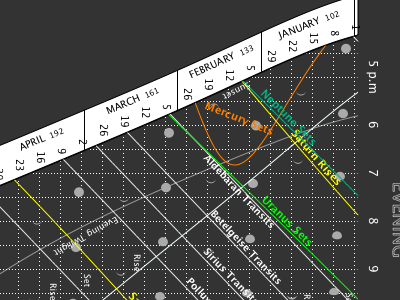
Birmingham Central Reference Library, as part some mysterious rationalisation, has failed to stock the Astronomical Almanac for some years now. Vasyl Y. Choliy at the University of Kiev produces an almanac using the same underlying series. A recent addition has been the ‘amateur almanac’, an hourglass chart showing the main events throughout the year.
The osculating elements for finding the positions of the planets from a Kepler ellipse are included as well, I shall perhaps get round to updating my MS Excel spreadsheet with these elements soon.
Posted in Notes | Comments Off
January 28th, 2007
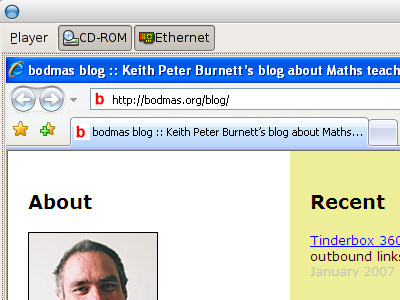
The instructions in a How To by Brett Alton work for Xubuntu 6.06 as given. Whatever you do, don’t try to set usb.present=”TRUE” in the .vmx file (line 28) to get your USB strick drive to work with both Windows under vmplayer and Xubuntu.
I tried that and I found my USB drives had their permissions changed so that they would no longer automount. Worse, chown and chmod could not restore the permissions. I did some Web searching but then gave up and re-installed (a cop out I know, but I don’t have that much time). Brett suggests using ssh to share files, setting up an ssh client on the Windows XP virtual machine and ‘logging in’ from Xubuntu. I shall try this, but I access the Internet using pppA and a USB modem so the ethernet port on Xubuntu does not have an IP address allocated.
Performance is slow. I currently have 256Mb allocated to the virtual machine (half the total RAM) and I’m hoping that things will speed up when I add another 512Mb. I use the VM for doing screen grabs of Office 2003 and MS Explorer 7 and trying out things with the new Office.
Posted in Ubuntu | Comments Off
January 27th, 2007
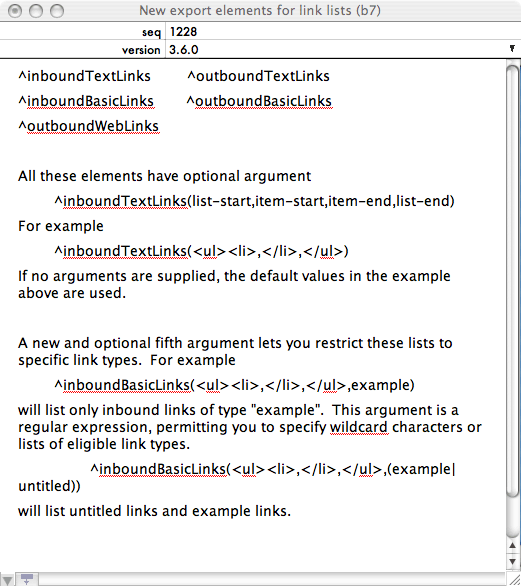
Tinderbox is getting larger (like me) and now comes with a bundled note taking application called Yojimbo, so we have a note taker for a note taker. Hummm
Tinderbox can be used to plan and implement heavily hyperlinked Web sites quickly. Unlike many note taking tools with a visual element (e.g. Inspiration, MindGenius and so on) Tinderbox comes with the facility to provide customiseable HTML export templates. You use template codes as placeholders for content that is generated when the Tinderbox document is exported to HTML files. Tinderbox allows visual hyperlinking of notes and links can be of different types. In my GCSE Maths mega mind map, I have link types like
- IsPartOf
- RelatedTo
- ContrastWith
Now I can list the links leading into a topic by these headings, as well as links from the topic to other topics using a single template tag in the code. When this never-ending project becomes publishable, a student landing on a given topic from a search engine (either the site search or Google) will see the topic as part of a nest of relationships to other topics – a schema already. Nice. Tinderbox is a reason for keeping the iBook as I move to open source operating systems mainly.
Posted in Notes | Comments Off
January 25th, 2007
Peter Blake did the cover of the [Beatles] Sgt. Pepper’s album, but the only reason that cover is famous is because it was the cover of Sgt.Pepper’s. When Sgt.Pepper’s goes out of copyright in a few years, all the people who played on that, the composers, their rights stop. Peter Blake’s don’t.
Keith Harris quoted in an interview with The Register journalist Andrew Orlowski. Put like this, the man has a point.
Posted in Notes | Comments Off
January 24th, 2007
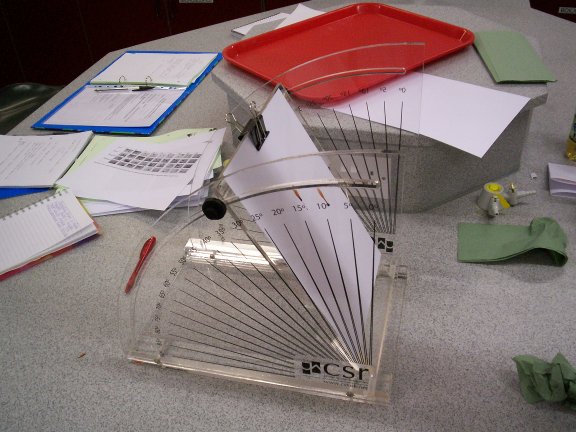
Summary :: Pupose made inclined plane makes practical work less confusing for students, and looks the part. Students studying a Maths unit as part of the BTEC National Certificate and Award in Forensic Scence find the practical work and relatively ‘real’ context motivates the Maths. As we all know, if students can be cajoled to do Maths, it sticks and then generates intrinsic motivation.
There is a simple formula (A = arcsin(w/l)) used to calculate the angle of impact of a liquid drop on a surface. The assumption is that the drop is spherical and that the stain will be elliptical – just like projecting a parallel beam of light of circular cross-section onto the surface. You just can’t beat the conic sections!
This formula is found in forensic science textbooks (White, Jackson & Jackson) as a way of working out the angle at which a blood stain hits a wall. I base part of a forensic maths assignment on an experimental test of this formula. Students have to
- work in pairs or threes to devise an experiment to test the formula
- discuss how to allow comparison of results between the groups
- carry out the experiment and note any changes to the plan that become necessary
- process and present the results including a quantitative estimate of the error bound for each angle they test
- discuss the results and come to a conclusion about how far they trust the formula
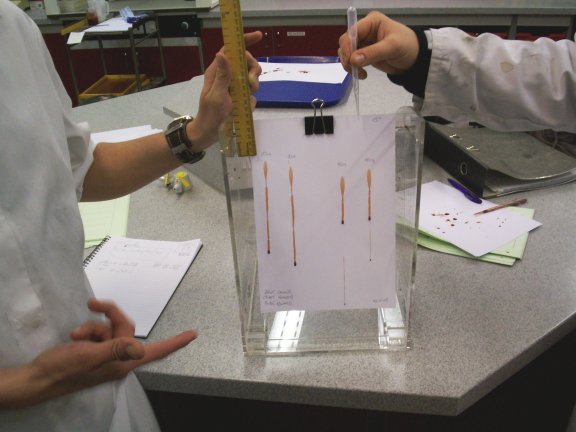
Forensic experts will tell you that the main point of blood stain pattern analysis is to determine the position of impact within a few metres (ie was the victim lying down or standing up when hit with the blunt instrument) so 5 degrees either way will decide the case. I encourage students to follow through a simple error analysis. Errors of two or three degrees are typical within the range 20 to 80 degrees. Errors can become larger outside that range.
The independent variable is the true angle of impact of the liquid drop, the dependent variable is the angle of impact estimated from the ellipse. Factors involve the nature of the paper surface and the viscosity and ‘thickening’ of the liquid. Central to the experiment is some kind of inclined plane.
Until recently, I have been using a dissection board propped against the wall and held with a 5Kg weight as the inclined plane. Students measured the length of the dissection board and then measured the height of the upper end of the board against the wall, and then used trigonometry to work out the angle between the board and the bench, the complimentary angle being the true angle of impact. This is a fairly long chain of arithmetic, and the calculations are dangerously similar to the calculation of impact angle from the ellipse. Some students get confused with the error calculation with the measurements of the dissection board and others find the geometry difficult to untangle. The independent and dependent variables become muddied in a sea of calculations.
I’ve checked the education supply companies, but there was nothing that seemed suitable. A small forensic science company called Crime Scene Resources is making ‘angle boards’ designed specifically for this kind of measurement, and we bought two on sight. The first experiment with a small group of evening class students has gone well. This simple (but nicely engineered) device has clarified the practical and made it possible for me to give evening class students a useful educational experience.
I usually wait for the simulated blood (a mixture of treacle and milk, recipe from Paul Smithard) to dry, then put the paper samples into plastic A4 pockets, and then I scan them. We load the results into PhotoShop and measure the width and length of the stain. An alternative is to import the scan into Word and use the drawing tools to match an ellipse to the stain, then right click and read off the size. A small US company supplies the HemoSpat bloodstain pattern analysis software. Perhaps someone should suggest that the UK spelling of haemo should appear in the site text somewhere! The company supplies a demo version for Mac OS X and Windows 2000/XP.
Related posts
Links
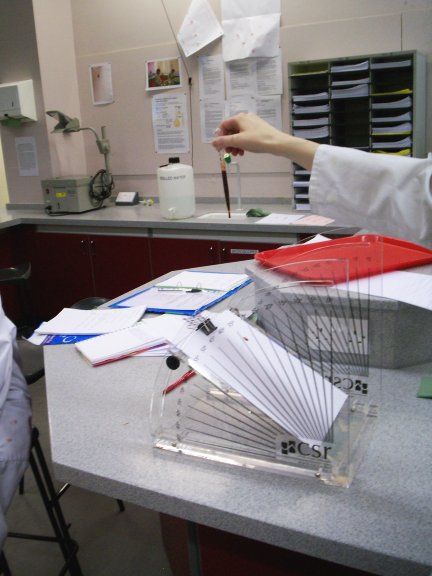
Posted in Forensic, Maths | Comments Off





